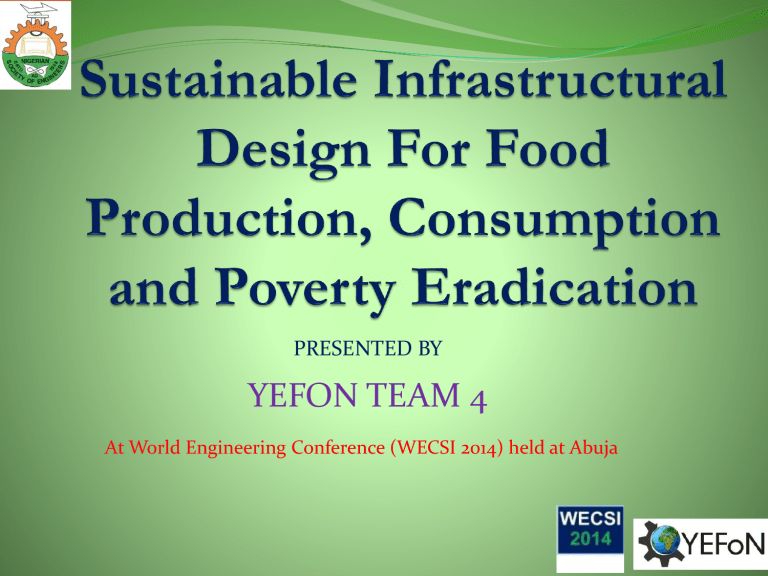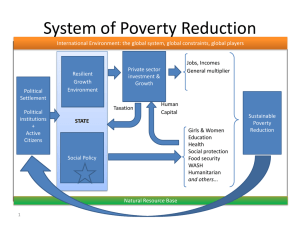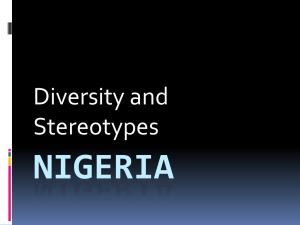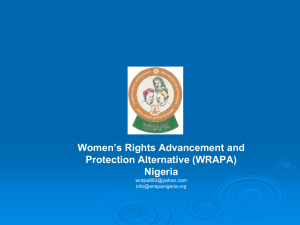here - YEFoN

PRESENTED BY
YEFON TEAM 4
At World Engineering Conference (WECSI 2014) held at Abuja
Project Supervisor:
Engr. Professor Simon V. Irtwange (FNSE)
Team 4 members
Ogunberu Samson Oluwaseun
Oyeleke Olukemi Oluwabukola
Balogun Ibrahim
Tugbobo Abiodun Joseph
Lewis-Wikina Sira M.O
Ajayi Solomon Oluwatobi
Nearly
870 million
people of the 7.1 billion people were suffering from chronic undernourishment in 2010 – 2012.
… (FAO, 2012)
AIM OF THE PROJECT
To come up with an infrastructure design that will enhance food production, consumption, poverty eradication.
and
•
•
•
•
•
NEW AND EMERGING CHALLENGES
Threats to agricultural production
Rising food prices
Population growth
Rapid diet changes
Poverty
NIGERIA SCENARIO
Population estimate of 173.6 million people (World Bank,
2013)
Seventh most populous country in the world with population growth at 3.2% per annum.
Over 80million hectares of arable land.
Largest economy in Africa, GDP > $500 Billion
A member of MINT group of countries
Among the “Next Eleven: economies set to become among the biggest in the world
NIGERIA SCENARIO
Nigeria so rich yet still ranked amongst the top 5 countries with highest number of people living poor i.e.
living below 1 US dollar/day (The World Bank 2014).
Poverty remains a challenge in Nigeria’s development efforts. On the other hand, relatively impressive economic growth rates were recorded during the 2000-
2007 period.
Agriculture account for
47% of the
GDP from
1960 - 2006
Nigeria Real GDP Growth
12
10
8
6
4
2
0
-2
Value
Change%
2003 2004 2005 2006 2007 2008 2009 2010 2011 2012 2013 2014
10,3 10,6 5,4 6,2 7 6 7 8 7,4 6,6 6,3 7,1
2,42% -49,0 15,17 12,25 -14,1 16,31 14,60 -7,77 -10,4 -4,85 13,87
POVERTY TREND IN NIGERIA
Poverty Level
(%) Estimated Total Population Poverty Population
28.1
65 million 17.7 million 1980
1985
1992
1996
2004
2010
46.3
42.7
65.6
54.7
60.9
75 million
91.5 million
102.3 million
126.3 million
159.2 million
34.7 million
39.2 million
67.1 million
69.09 million
96.8 million
2013 33.1
173.6 million 57.5 million
Sources: Based on the Harmonized Nigeria Living Standard Statistics (HNLSS, 2010), National
Bureau of Statistics (2007), World Bank (2013).
Agricultural sector is the single largest employer of labour forces
(70% according to
NBS, 2005)
“Roads, electricity supplies, telecommunications, and other infrastructure services are limited in all rural areas, although they are of key importance to stimulate
agricultural investment and growth”
- (Food and Agriculture Organization of the United
Nations (FAO) 1996, chapter 10, p.15)
Infrastructure
Infrastructure is the basic physical and organizational structures needed for the operation of a society like industries, buildings, roads, bridges, health services, governance and so on.
Food Production
Food production is the process of transforming raw ingredients into prepared food products.
Food Consumption
Food consumption refers to the amount of food or nutrient available for human consumption according to FAO Balance sheet
Poverty
Poverty, can be understood as a condition in which a person or community is deprived of, and or lacks the essentials for a minimum standard of well-being and life. Poverty is defined as the lack of or inability to achieve a socially, acceptable standard of living.
(Copenhagen World Summit on Social development (UN 1955),
POVERTY TREND IN NIGERIA
Poverty Level
(%) Estimated Total Population Poverty Population
28.1
65 million 17.7 million 1980
1985
1992
1996
2004
2010
46.3
42.7
65.6
54.7
60.9
75 million
91.5 million
102.3 million
126.3 million
159.2 million
34.7 million
39.2 million
67.1 million
69.09 million
96.8 million
2013 33.1
173.6 million 57.5 million
Sources: Based on the Harmonized Nigeria Living Standard Statistics (HNLSS, 2010), National
Bureau of Statistics (2007), World Bank (2013).
FOOD PRODUCTION IN NIGERIA
Agricultural production in
Nigeria has increased at slightly less than 1 percent per year, compared with about 2 percent in developing countries overall
FOOD PRODUCTION IN NIGERIA
Food Production Index
120
100
80
60
40
20
0
Sources: Based on data from www.indexmundi.com
.
(Food production index covers food crops that are considered edible and that contain nutrients over the past 50 years.)
FOOD CONSUMPTION IN NIGERIA
Food availability and affordability is still a concern
Soybean
3%
Sorghum
7%
Yam
10%
Cassava
16%
In Nigeria, the consumption pattern is skewed towards food
Rice
15%
Groundnut
11%
Plaintain
6%
Cowpea grain
12%
Food consumption is
2,710Kcal
Maize
20%
Maize is the number one staple food, followed by rice, as they provide humanity’s major source of carbohydrates in Nigeria.
Frequency of consumption of stable food crops at the national level
(Source: IITA Nigeria Food Consumption and
Nutrition Survey, 2003)
POVERTY ALLEVIATION PROGRAMMES IN NIGERIA
Operation Feed the Nation (OFN)- 1979
Green Revolution – (1979-1983)
Peoples Bank - (1985-1993)
Nigerian Agricultural Land development Authority (NALDA)
National Directorate of Employment (NDE)
Family Economic Advancement Programme (FEAP)- (1993 – 1998)
National Poverty Eradication Program (NAPEP) – 2001.
Youth Empowerment Scheme (YES)
Rural Infrastructures Development Scheme (RIDS)
Social Welfare Services Scheme (SOWESS)
Transformation Agenda
Sustainability Development
Sustainable development is development that meets the needs of the present without compromising the ability of future generations to meet their own needs. It contains within it two key concepts: the concept of needs, and the idea of limitations imposed by the state of technology and social organization on the environment’s ability to meet present and future needs.
DESIGNING THE INFRASTRUCTURE:
The need for appropriate infrastructure is an urgent and ongoing global requirement. Sufficient infrastructure is indispensable for economic development. This helps to determine a country’s success or failure in diversifying production, coping with population growth, reducing poverty, improving environmental conditions, etc.
In order to provide a framework for sustainable infrastructure for food production, food consumption and poverty eradication, it is imperative to view and analyze infrastructure as it relates to the three broadly-accepted sub-categories of sustainability: environmental sustainability, economic sustainability, and social sustainability.
DESIGNING THE INFRASTRUCTURE:
CURRENT STATUS
84 Million Hectares of Arable land
263 Billion cubic metres of water
200,000 Km of road networks
Power generation in the country is about 4000MW.
Nigeria electricity consumption per capita is 111 kWh
The railway now accounts for less than 1% of land transport in the country.
INFRASTRUCTURE DESIGN OPTIONS FOR
ENHANCED FOOD PRODUCTION
SUSTAINABLE INFRASTRUCTURE DESIGN
MODEL
MODEL 1
MODEL 1
MODEL 2
MODEL
SUSTAINABLE INFRASTRUCTURE
DESIGN: BENEFITS TO THE POOR
• Reduce transaction costs and facilitating trade flows within and across borders.
• Lower the costs of inputs used in the production.
• Open up new opportunities for entrepreneurs.
• Creates employment, including in public works
• Improve access to schools and health centres.
• Improve environmental conditions, which link to improved livelihoods, better health and reduced poverty
CONCLUSION
The African saying that “once the problem of food is addressed in the life of a poor fellow, the poverty level has been substantially solved” remains valid.
There is a direct correlation between the level of poverty in
Nigeria and development of agriculture.
Hence, enhanced food production and consumption is a sine aqua non for alleviation of poverty.
CONCLUSION
Adequate provision of and investment in regional infrastructure ranging from rural roads and railways, to irrigation systems, telecommunications, clean water, agroprocessing centres, efficient electricity supplies and such basic social infrastructure as health, education, banking and commercial services, are Panacea for enhanced food production, food consumption and poverty eradication in
Nigeria, and Sub-Saharan Africa at large.
POLICY RECOMMENDATIONS
Provision of needed assistance to Nigerian farmers to transform and adopt the use of modern technology so as to stimulate higher productivity in agriculture and reduce the level poverty in the country.
Direct involvement and encouragement of private sector participation in mechanized farming system.
Proper monitoring of financial infrastructure policies by the necessary parastatals.
POLICY RECOMMENDATIONS
Provision of well-designed physical infrastructure (in both rural and urban communities) to facilitate higher agricultural productivity, distribution and minimize ruralurban drift so as to encourage farmers to concentrate in agricultural activities.
Finally, creation of an enabling environment of macroeconomic to encourage investment in agriculture by both indigenes and foreigners.
References
Food and Agriculture Organization, 2012; " The state of Food insecurity in the
World 2012“ http://fao.org/docrep/016/13027/e/3027e00.htm
Manyong V.M, A. Ikpi, J.K Olaleyemi, S.A., Yusuf B.T, Omonona V. Okuowa and F.S, Idacaba, 2005; Agriculture in Nigeria identifying opportunities for increased commercialization and investment IITA, Ibadan, Nigeria.
World Bank (2001).” World Development Report: Attacking Poverty, World
Bank, Washington D. C.









